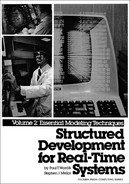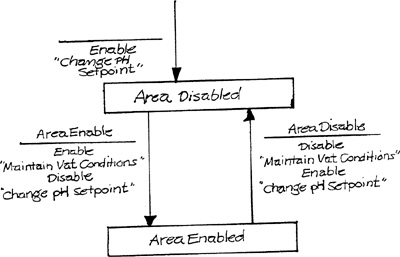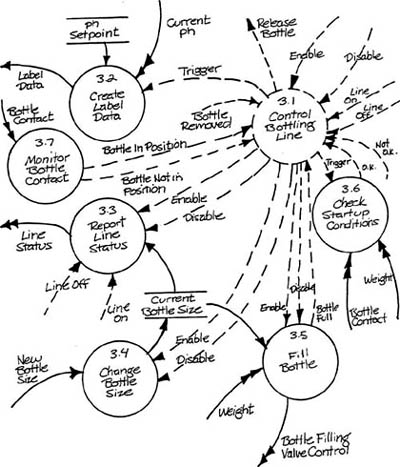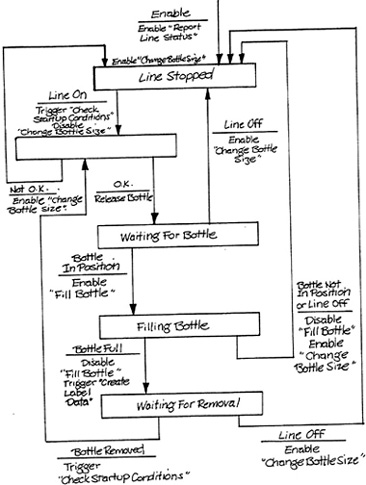Appendix B – Bottle-Filling System
TABLE OF CONTENTS
1. Background
2. Context Schema
3. Event List
4. Leveled Set of Schemas
5. Data Dictionary
6. Transformation Specifications
Problem Statement
This system consists of a number of bottle-filling lines fed by a single vat containing the liquid to be bottled. Figure B.BKG shows some details of the vat apparatus and of a representative bottling line.
Because of the single vat, the composition of the liquid being placed in the bottles is identical for all lines at a given time. However, the bottle size may differ from line to line. For example, one bottling line might be filling one-liter bottles and another line might be filling five-liter bottles at 7:30 a.m., but both lines would be using liquid maintained at a constant pH, say 6.52.
The tasks of the control system are to control the level and the pH of the liquid in the vat, to manage the movement and filling of bottles on the various lines, and to exchange information with human operators working the individual lines and with an area supervisor monitoring the entire system.
The vat level control is accomplished by monitoring the level with a sensor and adjusting a liquid input valve accordingly. The requirement for controlling pH arises because the liquid to be bottled reacts with its surroundings, causing the pH to “creep” over time. A constant pH is maintained by introducing, through a control valve, small quantities of a chemical that reverses the pH “creep.” The addition rate of the pH-changing chemical depends both on the current pH in the vat (measured by a pH sensor) and on the rate of flow of liquid through the tank (measured by the liquid input valve control).
Bottles to be filled on a particular line are drawn one by one from a supply of bottles, as follows:
![]() A bottle is released from a gate and drops down a chute onto a scale platform, at the same time depressing a bottle contact sensor.
A bottle is released from a gate and drops down a chute onto a scale platform, at the same time depressing a bottle contact sensor.
![]() The bottle-filling valve is opened, and a measured amount of liquid is let into the bottle. (The scale platform measures the weight of the bottle plus its contents, and is used to determine when the bottle is full and to shut off the valve).
The bottle-filling valve is opened, and a measured amount of liquid is let into the bottle. (The scale platform measures the weight of the bottle plus its contents, and is used to determine when the bottle is full and to shut off the valve).
![]() The filled bottle is labeled to show the actual pH when filled, and the nominal pH. The line operator caps and removes the filled bottle, and signals the system that the bottle has been removed. Removing the bottle releases the bottle contact sensor, removes the weight on the scale and allows the next bottle to be released from the gate.
The filled bottle is labeled to show the actual pH when filled, and the nominal pH. The line operator caps and removes the filled bottle, and signals the system that the bottle has been removed. Removing the bottle releases the bottle contact sensor, removes the weight on the scale and allows the next bottle to be released from the gate.
Figure B.BKG Equipment Configuration.
The line operators can signal the system to start and stop individual lines, and the supervisor can signal the system to enable or disable overall operation of the set of lines. For a line to start operation from stopped status, both the area enable and line start signals are necessary; in addition, the bottle contact must be off and the scale platform reading must be less than 0.1 gram. The line operators are given displays of the line status (on/off and current bottle size) and are able to change bottle size for the line. The area supervisor is given a display of the current status of the system pH and vat levels and statuses of the individual lines, and is able to change the pH of the bottled liquid by entering a new pH to be maintained.
If, during operation of the system, the pH goes out of limits (>0.3 from the setpoint) all control actions are suspended. The vat pH is then stabilized manually. When the pH is back within limits, the system restarts automatically.
Figure B.CS Context Schema.
Event List
Supervisor enables area.
Supervisor disables area.
Supervisor sets new pH level.
Operator turns line on.
Operator turns line off.
Operator sets new bottle size.
Operator removes bottle.
Bottle drops into place.
Bottle becomes full.
pH moves out of limits.
pH moves within limits.
Figure B.0 Operate Bottling System.
Figure B.1 Control Area.
Figure B.2 Maintain VAT Conditions.
Figure B.2.1 Control VAT Conditions.
Figure B.3 Operate Bottling Line.
Figure B.3.1 Control Bottling Line.
Data Dictionary
Transformation Specifications
2.2 Report Vat Status
Precondition 1
none
Postcondition 1
VAT STATUS
2.3 Control Input Valve
Precondition 1 (T=O)
0.83 < VAT LEVEL < 0.87
Postcondition 1 (T > 0)
0.83 < VAT LEVEL < 0.87
Precondition 2 (T=O)
VAT LEVEL ≤ 0.83 or ≥ 0.87
Postcondition 2 (T> O)
control action not defined
2.4 Control pH
Precondition 1 (T=O)
| CURRENT PH – PH SETPOINT | < 0.3
Postcondition 1 (T> O)
| CURRENT PH – PH SETPOINT | < 0.3
Precondition 2 (T = O)
| CURRENT PH – PH SETPOINT | ≥ 0.3
Postcondition 2 (T > O)
control action not defined
assumption: pH VALVE CONTROL = f(CURRENT pH, INPUT VALVE CONTROL)
Continuously
If CURRENT PH crosses from < (PH SETPOINT – 0.3) to > (PH SETPOINT – 0.3) or from > (PH SETPOINT + 0.3) to < (PH SETPOINT + 0.3) then
issue PH IN LIMITS
If CURRENT PH crosses from > (PH SETPOINT – 0.3) to < (PH SETPOINT – 0.3) or from < (PH SETPOINT + 0.3) to > (PH SETPOINT + 0.3) then
issue PH OUT OF LIMITS
3.2 Create Label Data
Precondition 1
none
Postcondition 1
LABEL DATA
3.3 Report Line Status
Continuously
LINE STATUS set to LINE IS ON if most recent signal received was LINE ON
LINE STATUS set to LINE IS OFF otherwise
Precondition 1
NEW BOTTLE SIZE
Postcondition 1
CURRENT BOTTLE SIZE = NEW BOTTLE SIZE
3.5 Fill Bottle
Local term: FULL WEIGHT is WEIGHT WHEN FULL corresponding to CURRENT BOTTLE SIZE from table (to be provided later)
Precondition 1 (T=O)
WEIGHT < FULL WEIGHT
Postcondition 1 (T > O)
0.999 * FULL WEIGHT < WEIGHT < 1.001 * FULL WEIGHT and bottle-filling valve closed in minimum possible time
3.6 Check Startup Conditions
Precondition 1
Weight ≤ 0.19 and BOTTLE CONTACT = OFF
Postcondition 1
OK
Precondition 2
WEIGHT > 0.19 or BOTTLE CONTACT = ON
Postcondition 2
NOT OK
3.7 Monitor Bottle Contact (Continuous operation)
Precondition 1
BOTTLE CONTACT changes from OFF to ON
Postcondition 1
BOTTLE IN POSITION
Precondition 2
BOTTLE CONTACT changes from ON to OFF
Postcondition 2
BOTTLE NOT IN POSITION








